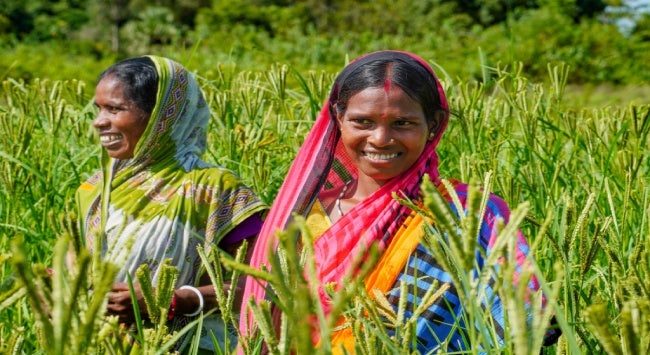Summary
The Indian government has strongly objected to the findings of the report on the Global Hunger Index and the report of the Food and Agriculture Organization of the United Nations on food security. This paper analyses the controversy and finds that there are merits and demerits in both the reports and the objections, which need to be carefully scrutinised further. There is a need for serious introspection on this subject by both the report producers and national governments. This is important because, among other things, the findings of these reports also inform the monitoring of countries’ progress in Sustainable Development Goal No 2, that is, ‘Zero Hunger’.
Introduction
The release of the Global Hunger Index: The Power of Youth in Shaping Food Systems 2023 (GHI Report 2023)[1] ignited a debate in India regarding the country’s hunger situation. The report shows that India’s Global Hunger Index (GHI) is higher[2] than that of most countries in South Asia. It is also higher than the South Asian and world averages. Soon after the release of the report, the Indian government rejected its findings, questioning the methodology and the data used for the calculation of the index.[3]
The state of food security and nutrition in countries worldwide is also reviewed and published periodically by the Food and Agriculture Organization (FAO) of the United Nations (UN) in its flagship State of Food Security and Nutrition Report. The 2023 edition of this report (FAO Report 2023) states that the Prevalence of Undernourishment (PoU) in India is 16.6 per cent of the country’s total population.[4] The Indian government rejected the figure on the PoU as well, saying that the PoU is calculated based on the Food Insecurity Experience Scale (FIES) survey that was conducted as an opinion poll of a mere 3,000 individuals.[5]
These global reports on the state of hunger, food security and nutrition not only provide country-level estimates but are also useful for making comparative assessments of countries’ progress with respect to other countries. The PoU and the severity of food insecurity data of the FAO are also used to track countries’ progress in the Sustainable Development Goal No. 2 (SDG 2), that is, ‘Zero Hunger’. Therefore, questions on the methodologies and data that are also used to take stock of the progress in SDG 2 are matters of grave concern. After all, the SDGs are a collective pledge of the UN member countries, and it is essential to periodically review the progress that countries are making towards achieving them so that corrective actions can be taken as and when necessary if countries are lagging in any of the SDGs.
Hence, in the context of the rejection of the GHI Report 2023 and the FAO data on the PoU by the Indian government, this paper reviews the concepts of food security, nutrition and hunger used in these global reports. It analyses the indicators that are used to produce the GHI and the FAO findings on the status of undernourishment and food insecurity. The paper also discusses the merit of the GHI and the FAO findings based on a comparative analysis of the status of hunger, food security and nutrition in the South Asian countries.
Concepts of Hunger and Food Security
Hunger and food insecurity are commonly understood as the state of experiencing physical discomfort arising from the lack of adequate food. However, global initiatives such as the introduction of the GHI, FAO’s food security monitoring, and SDG 2 define and measure hunger and food security from multidimensional lenses. For instance, as reflected in the indicators used to measure the GHI, hunger encompasses nourishment (caloric intake), nutrition (height and weight of children), and also child mortality (Table 1).
Table 1: GHI Indicators
Calculation of the GHI is based on the following four indicators:Undernourishment, which is the share of the population whose caloric intake is insufficient;
- Child stunting, which is the share of children aged below 5 years with low height for their age, reflecting chronic undernutrition;
- Child wasting, which is the share of children aged below 5 years with low weight for their height, reflecting acute undernutrition; and
- Child mortality, which is the share of children who die before their fifth birthday, reflecting in part the fatal mix of inadequate nutrition and unhealthy environments.
Source: GHI Report 2023[6]
To calculate the GHI, one-third of each weight is given to the undernourishment and mortality indicators, and one-sixth weight each is given to stunting and wasting indicators. Data on these indicators are collected from recognised global sources such as the FAO, World Health Organization (WHO), United Nations Children’s Fund (UNICEF) and others.
Similarly, an accepted definition of food security is, “Food security exists, when all people, at all times, have physical, social and economic access to sufficient, safe and nutritious foods to meet their dietary needs and food preferences for an active and healthy life.”[7] This definition encompasses four pillars that together determine the existence or lack of an individual’s food security (Table 2).
Table 2: Four Pillars of Food Security
- Availability: There needs to be enough good quality and nutritious food. This can be ensured through self-production at the individual or country level or through regional and global trade in food products.
- Access: Food availability alone is not useful if an individual lacks access to the food. While access to self-produced food is obvious, one needs a decent income to access available food in the market. Equitable food distribution at the intra-household level and in the case of public food distribution systems also determine access to food.
- Utilisation: Every individual should be able to utilise properly the ingested food, which necessitates individuals’ good health, proper handling of food, and good cleanliness and hygiene practices.
- Stability: All the above three components should be stable over time.
Source: FAO, 2009[8]
The FAO has conceptualised hunger as undernourishment; hence, it measures hunger in terms of the PoU, which it says is also a measurement of chronic food insecurity.[9] It measures the extent of food insecurity (severe and moderate food insecurity) based on the FIES when there is a lack of necessary national data. The FAO also separately measures stunting, wasting, overweight and obesity in children under five; anaemia in women between ages 15 and 49 years; and the lack of people’s capacity to afford a healthy diet as indicators of nutritional status, but does not combine them into a single indicator as the GHI to measure hunger or food security. Also, unlike the GHI, the FAO does not consider under-five mortality as an indicator of hunger or food insecurity.
Likewise, SDG 2 has the same indicators as, and thus draws data from, the FAO to monitor progress on targets 2.1 and 2.2 on hunger, food security and nutrition (Table 3). To monitor the progress on sustainable agriculture, which is essential for food security, the other targets under SDG 2 also include components such as agriculture productivity, genetic diversity, agriculture investments, and others.
Table 3: SDG 2: End Hunger, Achieve Food Security and Improved Nutrition and Promote Sustainable Agriculture (Targets 2.1 and 2.2, and Associated Indicators)
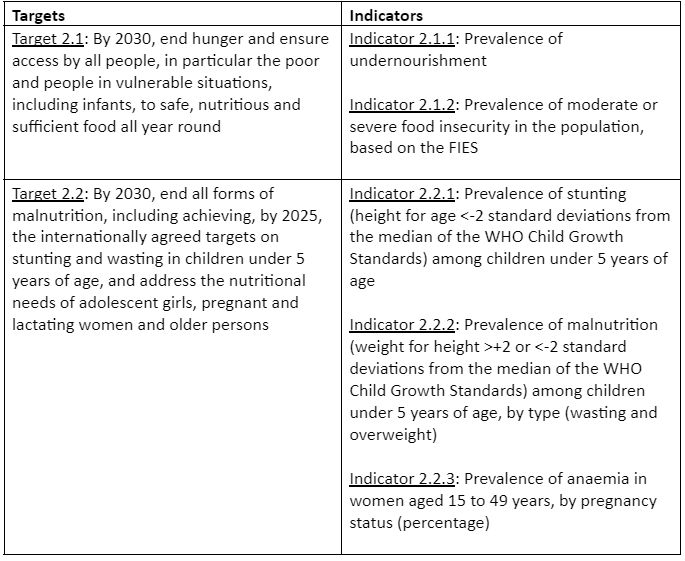
Source: UNDESA.[10]
Hence, the countries’ progress towards ‘zero hunger’ is also monitored based on their progress in undernourishment of the population and the nutritional status of children and women. Furthermore, it has been accepted by the UN member countries, which includes the South Asian countries, that measuring their progress towards sustainable agriculture is also necessary to take stock of their progress on SDG 2. However, SDG 2 also does not incorporate child mortality as an indicator of hunger.
Therefore, hunger and food security are multidimensional concepts and are thus measured in different ways. Controversies regarding the measurement of hunger and food security are due to the multidimensional nature of these concepts, and due to questions on the appropriateness of some of the indicators and quality of data that are used to measure them. Before we discuss the recent controversy in this respect, it would be useful to undertake a quick review of the findings of the GHI Report 2023 and the FAO Report 2023 on the state of hunger and food security in South Asia.
GHI Report 2023
The findings of the GHI Report 2023 in relation to the status of hunger in South Asian countries, for which data are available, are presented in Table 4. The six South Asian countries have maintained their 2015 rank orders in the region in 2023, with Sri Lanka at the top of the rank and Afghanistan at the bottom in both 2015 and 2023.[11] The GHI scores of all six countries have also reduced every year since 2000, reflecting improvements in the severity of hunger in these countries. Bangladesh and Nepal – two least-developed countries (LDCs) in the region – appear to have made impressive progress in addressing the problem of hunger over the years.
Table 4: South Asian Countries’ GHI Scores and Ranks, 2000-2023
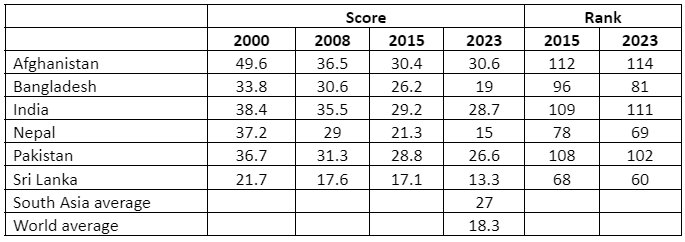
Source: GHI Report 2023.[12]
Despite improvements in their individual GHI scores, the low performance of South Asian countries in comparison with other countries around the world is concerning. In particular, the GHI scores of Afghanistan, India and Pakistan are much higher than the world average, and their place among the lowest-ranked 25 countries out of a total of 125 countries has been a serious issue in South Asia. As stated earlier, India has objected to this finding.
FAO Report 2023
As alluded to earlier, the FAO measures the extent of hunger using the PoU indicator, which is based on the number of people who do not have regular access to enough calories or dietary energy for an active and healthy life. Generally, the PoU is calculated based on country data on food availability, consumption, and dietary energy needs. It also partly draws on data on food consumption (or access to food) from the FIES survey[13] when the latest country data on the same are unavailable. FIES survey data are used to estimate the severity of food insecurity, that is, to measure the prevalence of moderate and severe food insecurity in the population.
Unlike the GHI, which combines data on caloric intake, child stunting and wasting, and child mortality to calculate a single index, the FAO separately presents data on undernourishment and child malnutrition (stunting, wasting and overweight). It also measures anaemia in women aged 15-49 years as an indicator of nutrition.
The FAO Report 2023 shows that South Asia, as a region, lags in the progress on the PoU compared to the world average (Table 5). A few countries, such as Nepal and Sri Lanka, have made tremendous progress in reducing the PoU. Other countries in the region have also made progress over the years. However, the PoU in these countries being substantially higher than the world average shows that South Asia still has a long way to go in reducing undernourishment. This finding resonates with that of the GHI.
Table 5: Prevalence of Undernourishment in Total Population (%)

Source: FAO Report 2023[14]
More worrisome is the state of child undernutrition in South Asia. In all the countries except the Maldives and Sri Lanka, the prevalence of stunting in children under five has been higher than the world average, particularly due to the ‘very high’ prevalence of stunting in Afghanistan, India and Pakistan (Table 6).[15] Regarding wasting in children under five, there are scant data for different years for different countries. The FAO draws data on this indicator from the UNICEF. The latest available UNICEF data on this indicator, collected from national sources, show that Bangladesh, Nepal, and Pakistan have made some progress in reducing child wasting over the years, but the progress in other South Asian countries is not encouraging (Table 7). Particularly noteworthy are India and Sri Lanka, with the prevalence of wasting above 15 per cent,[16] which the Indian government denies for India.
Table 6: Prevalence of Stunting in Children under Five (%)
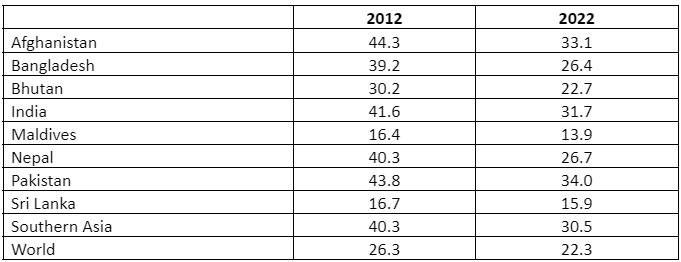
Source: FAO Report 2023[17]
Table 7: Wasting in Children under Five in South Asia
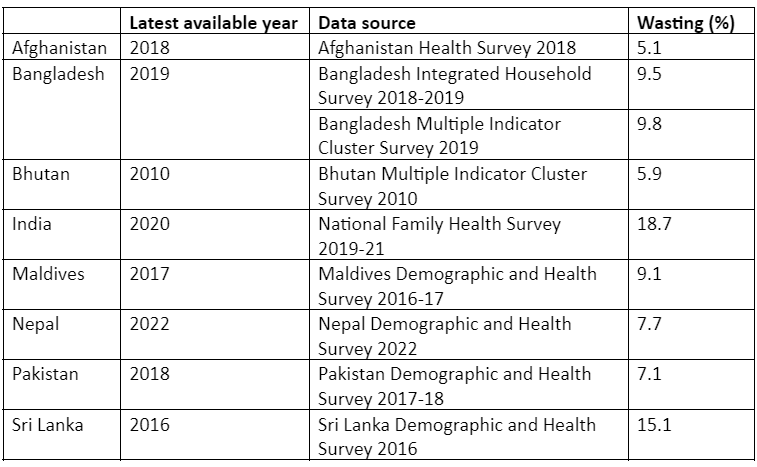
Source: UNICEF[18]
The FAO Report 2023 also shows a gloomy picture regarding people’s access to healthy diets. It finds that more than three billion people in the world (42.2 per cent of the world population) are unable to afford a healthy diet. More than 1.4 billion of them live in South Asia, which is more than 72 per cent of the region’s population. Most of the countries in the region have faltered in this respect (Table 8).
Table 8: Cost of a Healthy Diet and the Number and Percentage of People Unable to Afford It

Source: FAO Report 2023[19]
It appears contradictory that even in countries that have made better progress in undernourishment, such as Nepal, a significantly larger proportion of the population is unable to afford a healthy diet. Given that the different indicators used to measure hunger, undernourishment, nutrition status, and affordability of a healthy diet show different aspects of food security, they need to be interpreted accordingly. However, there could also be inconsistencies and incompatibilities leading to controversies such as the recent one. Thus, it is important to delve into these issues seriously and address the problems, if any, or provide the necessary clarifications to the questions at the centre of the controversy.
Analysing the Controversy
As stated earlier, the Indian government has objected to the findings of both – the GHI Report 2023 and the FAO Report 2023. It has particularly stated the following four reasons for its rejection of the GHI Report, of which the last two are also the reasons for the rejection of the FAO findings:
- The indicators related to the undernutrition status of children below five years have two-thirds weight in the GHI, which is not sensible in measuring the state of hunger of the entire population of a country.
- It is wrong to include under-five mortality as an indicator to measure hunger. Under-five mortality, and also stunting and wasting are results of several factors, of which the lack of food might be just a small factor.
- The figure on the prevalence of wasting in children under five that has been used to calculate the GHI is much higher than the latest Indian government data.
- The PoU, one of the indicators used to calculate the GHI, is based on the FIES survey. Since this survey is administered on an extremely small share of the total population, it does not reflect the true state of undernourishment in the country.
The first two reasons appear to have some merit. It might not be appropriate to measure the status of ‘hunger’ of the ‘entire population of a country’ giving two-thirds weight to indicators that show children’s nutritional status. While these indicators are important in their own right, combining them to show the status of ‘hunger’ might need rethinking. The FAO measures ‘hunger’ in terms of the PoU. It should suffice to have this as the only measurement of hunger for international comparison purposes as well.
Regarding the under-five mortality indicator that has one-third weight in the calculation of the GHI, the GHI Report provides a reference to a 2013 study[20] published in the journal Lancet, which finds that undernutrition is responsible for 45 per cent of deaths in children under five. Since undernutrition is also the major cause of wasting and stunting, taking mortality as an indicator may lead to some duplication. Moreover, if undernutrition is an important factor that explains under-five stunting, wasting and mortality, then they should show a similar trend. In the case of South Asia, this is not the case. All South Asian countries have made impressive progress in reducing under-five mortality over the years, but they have lacked adequate progress in stunting and wasting (Figure 1). Furthermore, in the context that mortality is not considered an indicator to measure hunger and food security by the FAO, perhaps it would be useful to rethink this indicator in the calculation of the GHI.
Nevertheless, the inclusion of under-five mortality as an indicator to calculate the GHI should not be a reason for South Asian countries to dismiss the GHI altogether since the contribution of low under-five mortality values is very small in the GHI values of South Asian countries. It is the other three indicators—undernourishment, stunting and wasting—that have contributed significantly to the GHI, and FAO’s calculation of hunger and food insecurity are also based on these three indicators, albeit not in a single index.
The Indian government has refuted the finding that the prevalence of wasting in children under five in India is 18.7 per cent, which the GHI and FAO reports have drawn from UNICEF. The Indian government states that only seven per cent of the children under five in India have low weight for their height according to the ‘Poshan Tracker’ app.[21] While the latest UNICEF data on child wasting in India (18.7 per cent) are from the National Family Health Survey 2020, the ‘Poshan Tracker’ data are more recent. The prevalence of under-five wasting in India might have reduced in the past three years, but did it reduce so impressively from 18.7 per cent in 2020 to seven per cent in 2023, or are there other factors that explain this discrepancy? This is a serious question to ponder upon.
Figure 1: Under-five Mortality in South Asian Countries
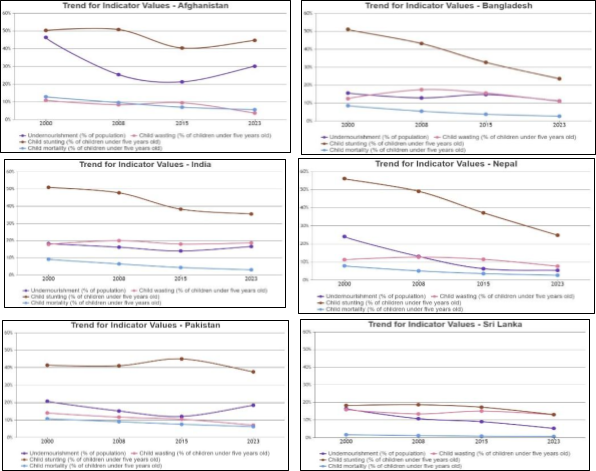
Source: Global Hunger Index online.[22]
Finally, regarding the criticism that the PoU values are calculated based on the FIES survey, this is not entirely the case, according to the FAO. The FIES survey data are collected to measure the severity of food insecurity, and that too in cases where the necessary and up-to-date national data are not available. The FAO presents the findings on the severity of food insecurity separately from the PoU. To calculate the PoU, the FAO only partly draws on the FIES survey data when there is a lack of other broad-based national data on the same heading. Therefore, the PoU values presented by the FAO and used in the calculation of the GHI should not be dismissed entirely.
Conclusion
The recent debate ensued by the publication of the GHI and the FAO report on food security, and the Indian government objections to the findings of these reports call for serious introspection on this subject by both the report producers and national governments. The merits and demerits of both the reports and the objections need to be carefully scrutinised.
As discussed above, the GHI is based on the same data sources as the FAO’s hunger and food security measurement, except for under-five mortality. Since the FAO produces regular reports on food security and nutrition without combining the different indicators, perhaps the construction of the GHI was initiated to make a new contribution through the addition of a new indicator (under-five mortality) and presenting the status of hunger through a single index. Is it necessary to have a single index combining ‘undernourishment in the population’ and ‘under-five nutritional status’, including under-five mortality? Does this add value to existing knowledge? This is an important question to reflect upon. If the GHI makes an additional contribution, perhaps there is a need to revisit the indicators used to construct the index. More importantly, there is a need to rethink the name given to the index. ‘Hunger’ is a politically sensitive term, and it is generally perceived differently. Perhaps the name of the index is more concerning at present. Therefore, naming the index appropriately is essential.
The PoU is a better indicator to show the status of ‘hunger’. Questions regarding data underlying the calculation of the PoU do not appear to be well-founded. Countries should be careful in their objections to certain results, which are also the basis of monitoring progress in other development indicators they have agreed to. For example, target 2.1 and target 2.2 under SDG 2 on ‘Zero Hunger’ are drawn from the widely accepted FAO’s definition of hunger and food security. Accordingly, the indicators identified to measure these targets are also drawn from FAO’s measurements. Indicators for target 1 to measure hunger are the PoU and the FIES, and indicators to measure target 2 are the height and weight of children under five and the prevalence of anaemia in women aged 15-49 years. Thus, it follows that countries’ progress in the first two targets under SDG 2 reflects their progress measured by the FAO on the status of hunger, food security and nutrition. In most South Asian countries, given their lacklustre performance in these indicators, their progress on SDG 2 has been extremely slow. At this pace, South Asia will not achieve the zero-hunger goal by 2030. To dismiss the FAO’s findings would also mean rejecting the SDG 2 progress report.
Nevertheless, data-related problems, such as data unavailability, data inaccuracy, and so on, are features of many developing countries. Therefore, extra effort needs to be made to ensure and enhance the availability, quality, consistency and reliability of data. Regular data collection on important indicators at the country level should be a high priority for all governments. Initiatives such as India’s ‘Poshan Tracker’ could be useful. The current controversy should be taken as an opportunity to reflect on the shortcomings and make necessary changes.
. . . . .
Dr Puspa Sharma is a Visiting Senior Research Fellow at the Institute of South Asian Studies (ISAS), an autonomous research institute in the National University of Singapore (NUS). He can be contacted at puspa.sh@nus.edu.sg. The author bears full responsibility for the facts cited and opinions expressed in this paper.
[1] Welthungerhilfe and Concern Worldwide, “Global Hunger Index: The Power of Youth in Shaping Food Systems”,12 October 2023.
[2] Higher the GHI, worse the hunger situation. GHI scores indicate the hunger situation as follows: ≤ 9.9 (low); 10–19.9 (moderate); 20–34.9 (serious); 35–49.9 (alarming); ≥ 50 (extremely alarming).
[3] Ministry of Women and Child Development, Government of India, “Global Hunger Index continues to be an erroneous measure of hunger with serious methodological issues and shows a malafide intent; Government is committed to ensure food security of its citizens”, Press Release, 12 October 2023, https://pib.gov.in/PressReleaseIframePage.aspx?PRID=1967164.
[4] FAO, IFAD, UNICEF, WFP and WHO, The State of Food Security and Nutrition in the World 2023: Urbanization, Agrifood Systems Transformation and Healthy Diets across the Rural–Urban Continuum (Rome: FAO, 2023).
[5] Ministry of Women and Child Development, Government of India, op. cit.
[6] Welthungerhilfe and Concern Worldwide, Global Hunger Index: The Power of Youth in Shaping Food Systems,12 October 2023.
[7] Food and Agriculture Organization (FAO), “Declaration of the World Summit on Food Security”, Food and Agriculture Organization of the United Nations (FAO), November 2009, https://www.fao.org/3/k6050e/k6050e.pdf.
[8] Ibid.
[9] FAO et al., The State of Food Security 2023, op. cit.
[10] United Nations Department of Economic and Social Affairs, “Goal 2: End hunger, achieve food security and improved nutrition and promote sustainable agriculture”, https://sdgs.un.org/goals/goal2.
[11] Lower rank value shows better performance.
[12] Welthungerhilfe and Concern Worldwide, 2023, op. cit.
[13] According to the FAO, FIES are estimates based on national data, where available, and FAO estimates based on polls such as Gallup. The survey consists of eight questions, and is conducted in around 1,000 people in each country where the survey is administered. But in India and China it is administered in 3,000 and 3,500 people, respectively, due to their huge population size. In the Annex to the FAO Report on the State of Food Security and Nutrition 2023, the FIES data are not available for Bhutan and they are not provided for India.
[14] FAO et al., The State of Food Security 2023, op. cit.
[15] The prevalence of stunting ≥ 30 per cent is considered ‘very high’ according to the WHO, https://www.who.int/data/nutrition/nlis/info/malnutrition-in-children.
[16] The prevalence of wasting ≥ 15 per cent is considered ‘very high’ according to the WHO, https://www.who.int/data/nutrition/nlis/info/malnutrition-in-children.
[17] FAO et al., The State of Food Security 2023, op. cit.
[18] These data and those for previous years are available at the United Nations Children’s Fund, “Child Malnutrition”, https://data.unicef.org/topic/nutrition/malnutrition/#data.
[19] FAO et al., The State of Food Security 2023, op. cit.
[20] Black, R. E., C. G. Victora, S. P. Walker, Z. A. Bhutta, P. Christian, M. de Onis, M. Ezzati, et al., “Maternal and Child Undernutrition and Overweight in Low-Income and Middle-Income Countries”, Lancet, vol. 832, no. 9890 (2013): 427-51.
[21] India has developed and launched the ‘Poshan Tracker’ app to monitor child nutrition in almost real time. https://negd.gov.in/poshan-tracker/.
[22] The Global Hunger Index, “The Power of Youth in Shaping Food Systems-Data”, https://www.globalhungerindex.org/.
Pic credit: UNWFP’Twitter account
-
 More From :
More From :
-
 Tags :
Tags :
-
 Download PDF
Download PDF



